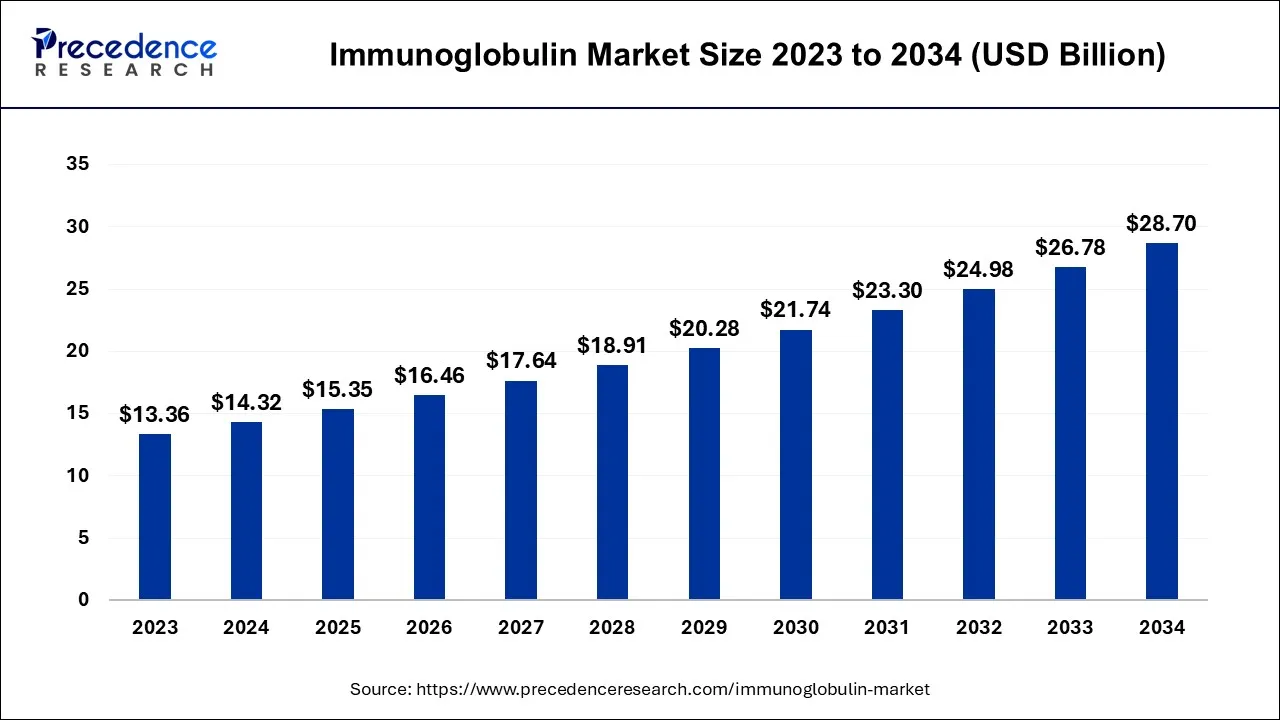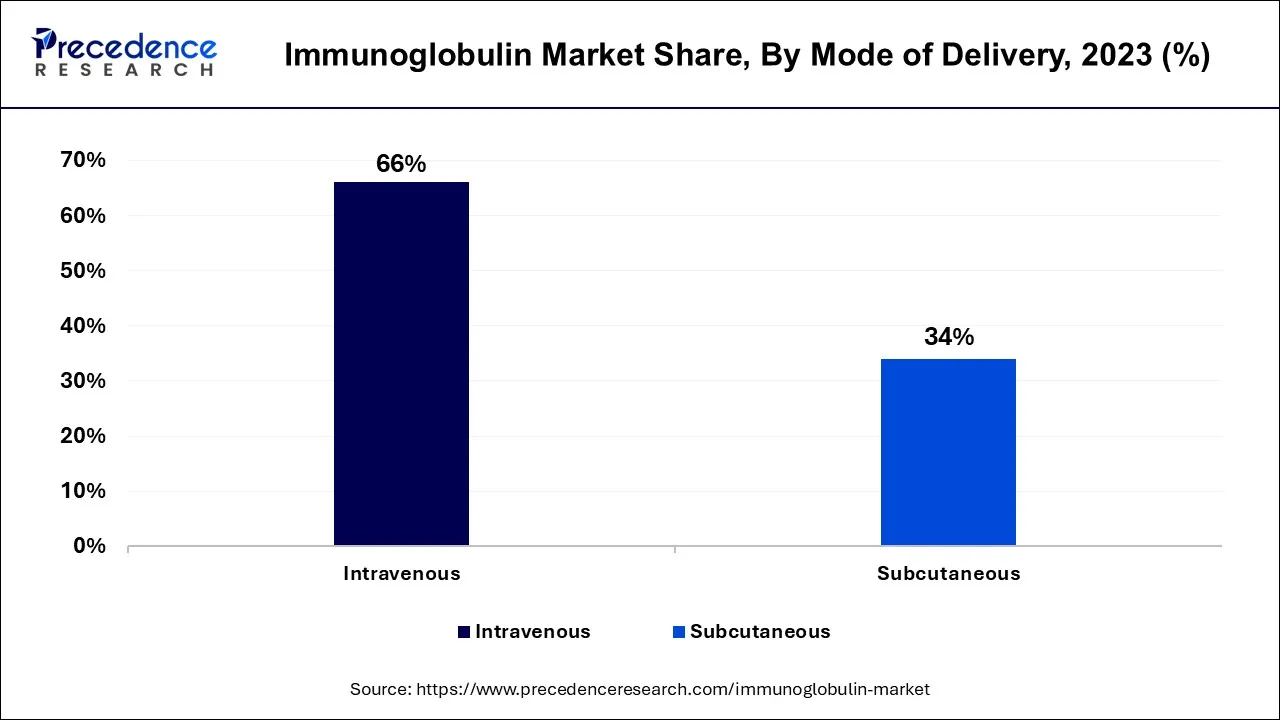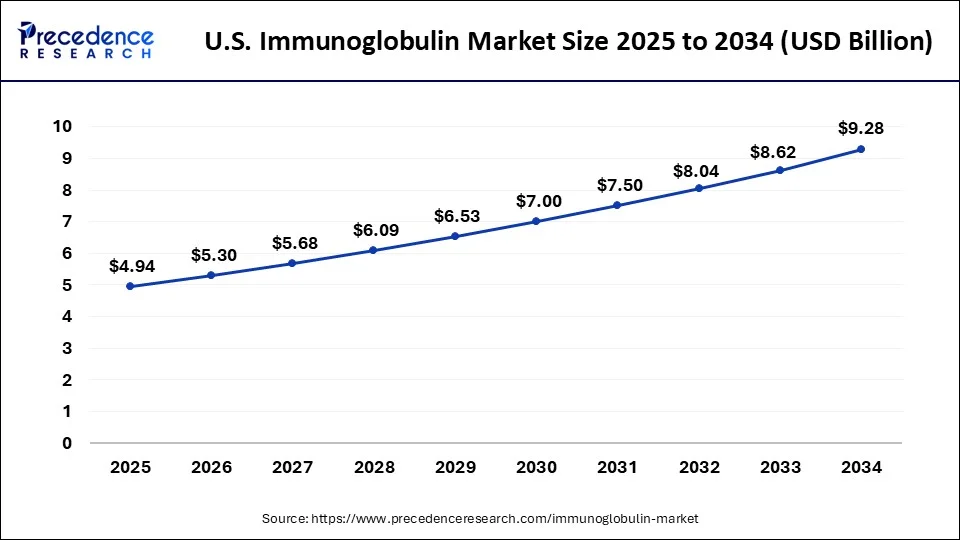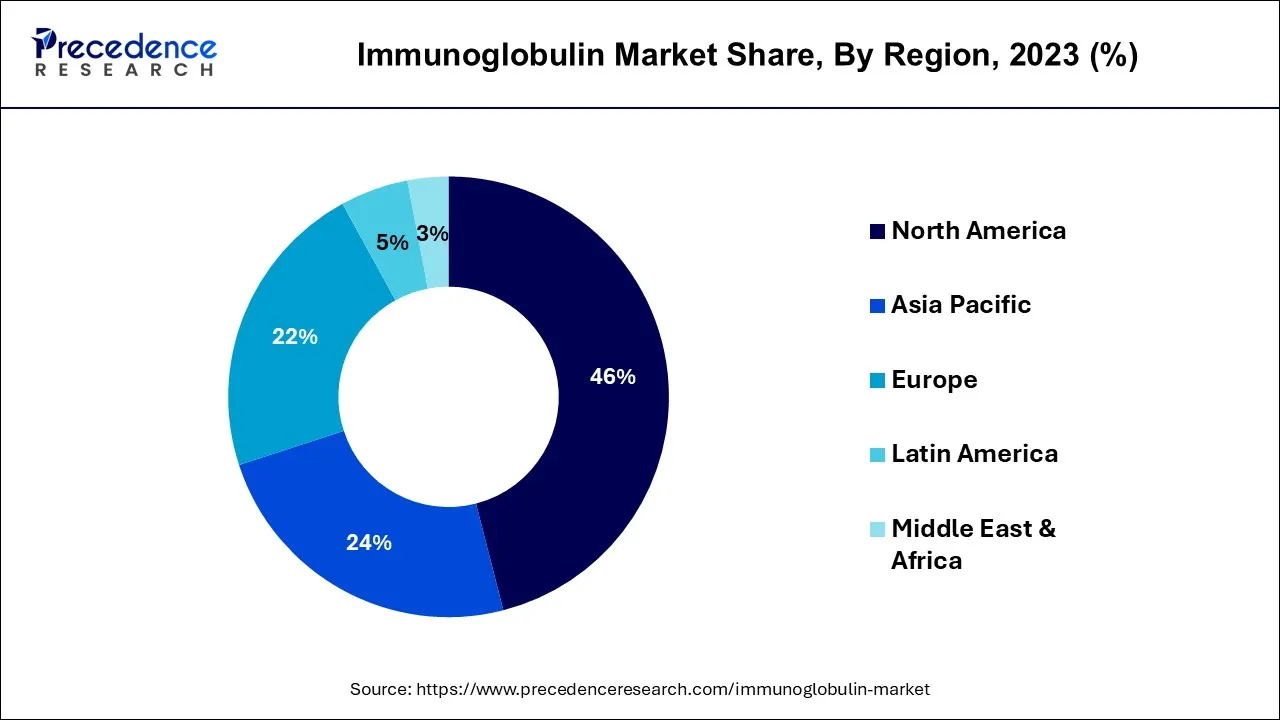List of Contents
What is the Immunoglobulin Market Size?
The global immunoglobulin market size is accounted at USD 15.35 billion in 2025 and predicted to increase from USD 16.46 billion in 2026 to approximately USD 28.70 billion by 2034, expanding at a CAGR of 7.20% over the forecast period 2025 to 2034.

Immunoglobulin Market Key Takeaways
- The global immunoglobulin market was valued at USD 14.32 billion in 2024.
- It is projected to reach USD 28.70 billion by 2034.
- The immunoglobulin market is expected to grow at a CAGR of 7.20% from 2025 to 2034.
- North America contributed more than 46% market share in 2024.
- Asia-Pacifica is estimated to witness the fastest CAGR between 2025 and 2034.
- By product type, the IgG (Immunoglobulin G) segment dominated the market with 69.40% share in 2024.
- By product type, the hyperimmune immunoglobulins segment is expected to grow at the highest CAGR of 8.70% over the forecast period.
- By application, the primary immunodeficiency diseases segment held a 25.80% market share in 2024.
- By application, the primary immunodeficiency diseases segment held a 25.80% market share in 2024.
- By route of administration, the Intravenous (IVIG) segment held a 73.20% market share in 2024.
- By route of administration, the subcutaneous (SCIG) segment is expected to grow at the highest CAGR of 9.10% during the projected period.
- By distribution channel, the hospital pharmacies segment dominated the market with a 51.60% share in 2024.
- By distribution channel, the online pharmacies segment is expected to grow at the highest CAGR of 10.40% during the forecast period.
Market Overview
The immunoglobulin market centers on the production, distribution, and utilization of immunoglobulin products, also known as antibodies. These proteins play a crucial role in the immune system, offering passive immunity against various diseases. The market is driven by the rising prevalence of immunodeficiency disorders, autoimmune diseases, and neurological conditions. Key players focus on developing and commercializing immunoglobulin therapies, including intravenous and subcutaneous formulations. Growing awareness, technological advancements, and an aging population contribute to the market's expansion, with immunoglobulin products serving as vital therapeutic options in addressing a spectrum of medical conditions.
The immunoglobulin market witnesses continuous growth due to advancements in plasma collection techniques and purification processes. Increasing research and development activities, along with expanding applications in areas such as neurology and hematology, further propel market dynamics.
- In December 2023, launched on its SUREtechnology Platform, KBI Biopharma, Inc., a JSR Life Sciences subsidiary, introduced SUREmAb, a product for optimal, safe, and economical monoclonal antibody (mAb) development and manufacture. According to the company, SUREmAb is a globally integrated vertical solution intended to reduce development timelines for multinational biopharmaceutical manufacturers. It can accomplish research cell bank (RCB) development in as little as nine weeks and enable clients to transition from DNA to GMP drug substance in as little as eleven months.
- In January 2023, Astellas Pharma Inc. and Selecta Biosciences, Inc. announced an exclusive license and development deal for IdeXork (Xork). Astellas is investigating Xork as a prospective next-generation immunoglobulin G (IgG) protease to be used with AT845, an experimental adeno-associated virus (AAV)-based treatment for adult Late-Onset Pompe disease (LOPD).
- In September 2023, Eisai Co., Ltd. and Biogen Inc. announced that LEQEMBI Intravenous Infusion (200 mg, 500 mg, lecanemab), a humanized anti-soluble aggregated amyloid-beta (Aβ) monoclonal antibody, has been approved in Japan as a treatment for mild dementia and mild cognitive impairment (MCI) caused by Alzheimer's disease (A.D.).
- In March 2022, Sanofi and IGM announced up to $6 billion Antibody Partnership; Sanofi said that it will collaborate with IGM Biosciences to develop, produce, and market six immunoglobulin M (IgM) antibody agonists; three of these targets will target immunology/inflammation, while the remaining three will target cancer. The collaboration carries a potential milestone payment commitment of more than $6 billion.
Immunoglobulin Market Growth Factors
- Ongoing advancements in plasma collection methods and purification processes enhance the efficiency and safety of immunoglobulin products.
- The aging demographic worldwide is a significant driver, as immunoglobulin therapies are frequently used in addressing health issues prevalent in older individuals.
- Growing research broadens the applications of immunoglobulin, finding utility in neurology, hematology, and various medical specialties.
- Increased awareness among healthcare professionals and patients regarding the benefits of immunoglobulin therapies fuels market growth.
- Advances in plasma collection technologies contribute to the scalability and efficiency of the immunoglobulin manufacturing process.
- Ongoing research and development activities focus on innovating immunoglobulin therapies, introducing novel formulations and treatment modalities.
- Market expansion is facilitated by improved global market access, ensuring a broader reach for immunoglobulin products.
- Tailored immunoglobulin therapies catering to specific patient populations create niche opportunities and foster market diversification.
- Increased healthcare spending globally contributes to the accessibility of immunoglobulin therapies, making them more widely available.
- The shift towards subcutaneous administration presents an opportunity for market players to provide convenient and patient-friendly delivery options.
- Strategic collaborations between pharmaceutical companies and research institutions drive innovation and strengthen the immunoglobulin market's competitive landscape.
- Immunoglobulin therapies find increasing application in neurological disorders, presenting a significant growth avenue.
- Supportive regulatory frameworks ensure the safety and efficacy of immunoglobulin products, instilling confidence in healthcare professionals and patients.
- Opportunities abound in emerging markets where there is a growing demand for advanced immunoglobulin therapies, creating avenues for market expansion.
Market Scope
| Report Coverage | Details |
| Growth Rate from 2025 to 2034 | CAGR of 7.20% |
| Market Size in 2026 | USD 16.46 Billion |
| Market Size in 2025 | USD 15.35 Billion |
| Market Size by 2034 | USD 28.70 Billion |
| Largest Market | North America |
| Base Year | 2024 |
| Forecast Period | 2025 to 2034 |
| Segments Covered | By Application, By Product, and By Mode of Delivery |
| Regions Covered | North America, Europe, Asia-Pacific, Latin America, and Middle East & Africa |
Market Dynamics
Driver
Increasing prevalence of immunodeficiency disorders and autoimmune diseases and aging population
The immunoglobulin market experiences heightened demand due to the increasing prevalence of immunodeficiency disorders and autoimmune diseases globally. Broadening therapeutic applications of immunoglobulin propels market growth by expanding their utility beyond traditional uses. Ongoing research identifies novel applications in diverse medical specialties, such as neurology and hematology, creating new avenues for immunoglobulin therapies. This diversification not only addresses a wider range of medical conditions but also attracts increased demand, contributing to the market's sustained expansion.
The aging population further amplifies market demand, as older individuals are more susceptible to various health issues requiring immunoglobulin interventions. With aging often associated with a decline in immune function, immunoglobulin therapies become crucial for addressing age-related health challenges. As the world witnesses a demographic shift toward an older population, the immunoglobulin market is expected to meet the escalating healthcare needs associated with immunodeficiency disorders, autoimmune diseases, and age-related health conditions.
Restraint
High cost of immunoglobulin therapies, side effects and adverse reactions
The high cost of immunoglobulin therapies acts as a significant restraint on market demand. These therapies involve complex manufacturing processes and stringent quality standards, contributing to elevated production costs. As a result, patients, healthcare providers, and healthcare systems face financial challenges in accessing and affording these essential treatments. The cost factor limits the widespread adoption of immunoglobulin therapies, particularly in regions with limited healthcare budgets and resources.
Moreover, the presence of potential side effects and adverse reactions restrains market demand by impacting patient confidence and adherence. Immunoglobulin therapies can lead to adverse events, ranging from mild reactions to severe complications. Concerns about safety and potential adverse effects may deter both physicians and patients from opting for these therapies, hindering the overall growth and acceptance of immunoglobulin products in the healthcare landscape. Addressing these challenges is crucial for ensuring broader accessibility and sustained market growth.
Opportunity
Development of subcutaneous immunoglobulin and expansion of therapeutic applications
The development of subcutaneous immunoglobulin (SCIG) is a significant driver propelling the immunoglobulin market, offering patients a more convenient and patient-friendly administration option. This innovation enhances treatment accessibility, as SCIG allows individuals to self-administer immunoglobulin therapies outside of traditional healthcare settings. This shift towards subcutaneous delivery meets patient preferences, thereby increasing treatment adherence and expanding the overall market demand.
Furthermore, the expansion of therapeutic applications plays a crucial role in surging market demand. Immunoglobulin, once primarily associated with immunodeficiency disorders, now finds diverse applications in areas such as neurology, hematology, and autoimmune diseases. As research uncovers new therapeutic benefits, the versatility of immunoglobulin treatments grows, attracting a broader range of healthcare professionals and patients, and consequently, driving increased demand in the immunoglobulin market.
Application Insights
According to the application, the hypogammaglobulinemia segment has held 38% market share in 2024. Hypogammaglobulinemia refers to a condition characterized by lower-than-normal levels of immunoglobulin in the blood, leading to weakened immune function. In the immunoglobulin market, the treatment landscape for hypogammaglobulinemia has evolved with an increasing demand for immunoglobulin therapies. Advances in purification techniques and a growing patient pool contribute to a rising trend in the development and usage of immunoglobulin products tailored to address the specific needs of individuals with hypogammaglobulinemia.
The immunodeficiency disease segment is anticipated to expand at a significantly CAGR of 9.1% during the projected period. Immunodeficiency diseases involve a compromised immune system, leaving individuals susceptible to infections. Within the immunoglobulin market, the application of immunoglobulin therapies for immunodeficiency diseases is pivotal. Trends indicate a continuous expansion in therapeutic applications, as these therapies prove effective in managing and preventing infections in individuals with various forms of immunodeficiency diseases. Growing research and technological advancements contribute to the evolving landscape of immunoglobulin treatments for immunodeficiency diseases.
The primary immunodeficiency diseases segment held a 25.80% market share in 2024. The Immunodeficiency diseases involve a compromised immune system, leaving individuals susceptible to infections. Within the immunoglobulin market, the application of immunoglobulin therapies for immunodeficiency diseases is pivotal. Trends indicate a continuous expansion in therapeutic applications, as these therapies prove effective in managing and preventing infections in individuals with various forms of immunodeficiency diseases. Growing research and technological advancements contribute to the evolving landscape of immunoglobulin treatments for immunodeficiency diseases.
The autoimmune diseases segment is expected to grow at the highest CAGR of 9.30% over the forecast period. The growth of the segment can be attributed to the rise in incidence of autoimmune diseases, along with the rapid innovations in diagnostic techniques, which lead to more precise diagnoses. Also, R&D efforts are leading to more targeted and sophisticated immunoglobulin therapies.
Product Insights
Based on the product, the IgA segment held the largest market share of 41% in2024. Immunoglobulin A (IgA) is an antibody class playing a crucial role in mucosal immunity, primarily found in bodily secretions like saliva, tears, and mucous membranes. In the immunoglobulin market, the demand for IgA is driven by its significance in providing defense against infections at mucosal surfaces. Trends indicate a growing interest in research to harness IgA's potential therapeutic applications, particularly in addressing mucosal infections and immune deficiencies associated with mucosal immunity.
On the other hand, the IgG segment is projected to grow at the fastest rate over the projected period. Immunoglobulin G (IgG), the most abundant antibody in the blood, is central to systemic immune responses. In the immunoglobulin market, IgG holds a dominant position due to its versatility in targeting a wide range of pathogens. Trends highlight an increasing demand for specific IgG formulations tailored for various therapeutic applications, including autoimmune disorders and neurology. The market sees ongoing developments to enhance IgG therapies, ensuring optimized treatment outcomes across diverse medical specialties.
The IgG (Immunoglobulin G) segment dominated the market with a 69.40% share in 2024. In the immunoglobulin market, IgG holds a dominant position due to its versatility in targeting a wide range of pathogens. Trends highlight an increasing demand for specific IgG formulations tailored for various therapeutic applications, including autoimmune disorders and neurology. The market sees ongoing developments to enhance IgG therapies, ensuring optimized treatment outcomes across diverse medical specialties.
The hyperimmune immunoglobulins segment is expected to grow at the highest CAGR of 8.70% over the forecast period. The growth of the segment can be credited to the surge in incidence of neurological and autoimmune disorders, such as primary immunodeficiency diseases and other chronic diseases. An elderly population is more prone to immune-related disorders, further propelling segment expansion.
Mode of Delivery Insights
The intravenous segment held the highest market share of 66% in2024. Intravenous immunoglobulin involves the administration of immunoglobulin products directly into the bloodstream through a vein. This mode of delivery is characterized by its systemic and rapid distribution throughout the body. Trends in the immunoglobulin market show a historical preference for IVIG, particularly in critical conditions. However, advancements in technology and patient-centric care have prompted a shift towards alternative delivery methods, spurring innovation in the form of subcutaneous immunoglobulin (SCIG).

The subcutaneous segment is anticipated to expand at the fastest rate over the projected period. Subcutaneous immunoglobulin entails the injection of immunoglobulin under the skin, providing a slower, sustained release into the bloodstream. SCIG has gained prominence due to its convenience, allowing patients to self-administer at home. Trends indicate a growing acceptance of SCIG, driven by improved patient experience, reduced healthcare burden, and increased treatment adherence. The immunoglobulin market witnesses a trend towards personalized medicine, with SCIG offering a tailored and patient-friendly approach to immunoglobulin therapy.
Route of Administration Insights
The Intravenous (IVIG) segment held a 73.20% market share in 2024. Intravenous immunoglobulin involves the administration of immunoglobulin products directly into the bloodstream through a vein. This mode of delivery is characterized by its systemic and rapid distribution throughout the body. Trends in the immunoglobulin market show a historical preference for IVIG, particularly in critical conditions. However, advancements in technology and patient-centric care have prompted a shift towards alternative delivery methods, spurring innovation in the form of subcutaneous immunoglobulin (SCIG).
The subcutaneous (SCIG) segment is expected to grow at the highest CAGR of 9.10% during the projected period. Subcutaneous immunoglobulin entails the injection of immunoglobulin under the skin, providing a slower, sustained release into the bloodstream. SCIG has gained prominence due to its convenience, allowing patients to self-administer at home. Trends indicate a growing acceptance of SCIG, driven by improved patient experience, reduced healthcare burden, and increased treatment adherence. The immunoglobulin market witnesses a trend towards personalized medicine, with SCIG offering a tailored and patient-friendly approach to immunoglobulin therapy.
Distribution Channel Insights
The hospital pharmacies segment dominated the market with a 51.60% share in 2024. The dominance of the segment can be linked to the rapid innovations in IVIG therapies, coupled with the development of more efficacious immunoglobulin therapies. Moreover, many immunoglobulin therapies need administration by trained medical professionals in a clinical setting to ensure proper reimbursement processes.
The online pharmacies segment is expected to grow at the highest CAGR of 10.40% during the forecast period. The growth of the segment can be driven by growing patient demand for home-based care and the growth of telemedicine across the globe. Furthermore, online pharmacies provide home delivery, which is necessary for patients who need regular IG infusions for disease conditions.
Regional Insights
U.S. Immunoglobulin Market Size and Growth 2025 to 2034
The U.S. immunoglobulin market size is calculated at USD 4.94 billion in 2025 and is projected to be worth around USD 9.28 billion by 2034, poised to grow at a CAGR of 7.25% from 2025 to 2034.

North America has held the largest revenue share 46% in 2024. In North America, the immunoglobulin market reflects a robust demand driven by advanced healthcare infrastructure and a high prevalence of immunological disorders. The region witnesses a growing emphasis on subcutaneous immunoglobulin administration, aligning with patient preferences for at-home treatments. Ongoing research into expanding therapeutic applications and strategic collaborations further shapes the market landscape, with regulatory support ensuring the safety and efficacy of immunoglobulin products.
- In March 2023, The U.S. Food and Drug Administration (FDA) approved Balfaxar (prothrombin complex concentrate, human-lens; known as octuples in Europe and Canada) for the urgent reversal of acquired coagulation factor deficiency caused by vitamin K antagonist (VKA, e.g., warfarin) therapy in adult patients who require urgent surgery or invasive procedures, according to a press release from Octapharma USA.

Asia-Pacific is estimated to observe the fastest expansion. Asia-Pacific experiences dynamic trends in the immunoglobulin market, fueled by increasing healthcare awareness and a rising incidence of autoimmune diseases. The region sees a notable expansion in therapeutic applications, particularly in neurology and hematology. Accessibility to immunoglobulin therapies is enhanced by technological advancements and partnerships for localized manufacturing. Growing government initiatives for healthcare infrastructure development and immunization programs contribute to the market's steady growth in Asia-Pacific.
- In September 2023, India's major tug owners and operators were Adani Harbour Services Ltd. and Ocean Sparkle Ltd., which owned and operated over 100 tugs. In the presence of CSL Chairman and Managing Director Madhu S. Nair, Director (Technical) Bejoy Bhaskar, Udupi CSL CEO A. Harikumar, Deputy Commissioner K. Vidya Kumari, Coastal Security Police SP Anshu Kumar, and others, Ritu Sanjay Kumar Kewalramani and her spouse Adani Harbour Services CEO Sanjay Kumar Kewalramani named and launched the vessel.
In the European immunoglobulin market, advanced healthcare systems drive trends, emphasizing the development of subcutaneous immunoglobulin for patient convenience. The region experiences an expanding therapeutic landscape, incorporating immunoglobulin therapies in neurology and hematology. Collaborative research initiatives and stringent regulatory standards characterize Europe's commitment to immunoglobulin advancements, ensuring the safety and efficacy of treatments in addressing a spectrum of immunological disorders.
Immunoglobulin Market Companies
- Grifols, S.A.
- Shire
- CSL Behring
- Kedrion S.p.A.
- Octapharma
- Baxter International Inc.
- Biotest AG
- Bio Products Laboratory Ltd. (BPL)
- China Biologic Products Holdings, Inc.
- LFB SA
- Cangene Corporation
- Bharat Serums and Vaccines Limited
- Takeda Pharmaceutical Company Limited
- Bio Products Laboratory Ltd. (BPL)
- China National Pharmaceutical Group Corporation (Sinopharm)
Recent Developments
- In 2023, Everest Medicines gained approval from the Hainan Medical Products Administration for clinical use of Nefecon, a primary immunoglobulin A nephropathy (IgAN) drug, in China. This milestone marks progress in addressing IgAN, a condition affecting the kidneys, enhancing treatment options for patients in the region.
- In 2022, Grifols secured approval from European Union member state health authorities and the United Kingdom for XEMBIFY, a groundbreaking 20% subcutaneous immunoglobulin (SCIG). This innovative treatment is authorized for addressing primary and specific secondary immunodeficiency, marking a significant advancement in therapeutic options for these conditions.
- In 2021, Octapharma USA's investigational new drug (IND) application for a phase three clinical trial assessing the efficacy and safety of Octagam 10% [Immune Globulin Intravenous (Human)] therapy in severe COVID-19 patients received authorization from the U.S. Food and Drug Administration (FDA).
Segments Covered in the Report
By Product Type
- IgG (Immunoglobulin G)
- IgA (Immunoglobulin A)
- IgM (Immunoglobulin M)
- IgE (Immunoglobulin E)
- IgD (Immunoglobulin D)
- Hyperimmune Immunoglobulins
By Application
- Primary Immunodeficiency Diseases
- Secondary Immunodeficiencies
- Post-transplant Immunosuppression
- Cancer-related immunosuppression
- Chronic Inflammatory Demyelinating Polyneuropathy (CIDP)
- Hypogammaglobulinemia
- Congenital AIDS
- Immune Thrombocytopenic Purpura (ITP)
- Guillain-Barré Syndrome
- Kawasaki Disease
- Myasthenia Gravis
- Multifocal Motor Neuropathy
- Autoimmune Diseases
- Infectious Disease Prophylaxis
By Route of Administration
- Intravenous (IVIG)
- Subcutaneous (SCIG)
- Intramuscular (IMIG)
By Formulation Strength
- 5% Concentration
- 10% Concentration
- 20% Concentration
- Lyophilized Powder
- Liquid Solution
By Distribution Channel
- Hospital Pharmacies
- Retail Pharmacies
- Online Pharmacies
- Direct Supply / Tender-based Procurement
By Source
- Human Plasma-Derived Immunoglobulin
- Recombinant / Non-Plasma Derived Immunoglobulin
By Geography
- North America
- Europe
- Asia-Pacific
- Latin America
- Middle East and Africa
For inquiries regarding discounts, bulk purchases, or customization requests, please contact us at sales@precedenceresearch.com
Frequently Asked Questions
Ask For Sample
No cookie-cutter, only authentic analysis – take the 1st step to become a Precedence Research client